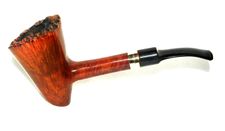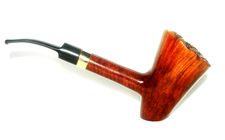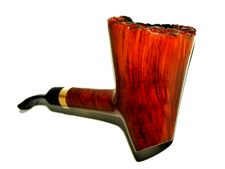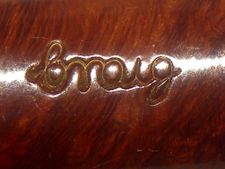Craig
Many thank to Hank Saatchi for discovering an interesting New York Times article from FEB. 18, 1973. The following excerpt contains interesting details about William Craig, and his pipes:
William D. Craig was once a chemical operator for Hercules Powder in Gibbstown. But he tired of shift work, converted his two‐car garage in Hurffville into a workshop, added the brick Fireside Pipe Shop to his small, one‐story frame house eight years ago and has been repairing and making pipes there since then.
Like Mr. Weinberger (JHW Pipes)), the 55‐year‐old Mr. Craig imports his briarwood only from Greece. Briar is the hard, woody root of the shrub or small tree used to make tobacco pipes. Mr. Craig said there were 1 steps to making a pipe, including drilling, sanding and staining, “not 154 steps like some people would like you to believe.”
Mr. Craig, who calls his custom pipes his “uniques,” said he had once fashioned “a molar‐shaped briar for dentists.”
Mr. Weinberger's novelty shaped pipes include not only a broad crown tooth for dentists, but also a cowboy boot, football helmet, airplane, golf club, sailing yacht in dry dock and a large bird beak.
“My philosophy on pipes,” he said, “is they should fit a man's face and general build for shape. Some want a deep bowl and long smoke. Others, usually former cigarette smokers, want a short smoke.”
“I sometimes make 15 to 20 pipes at one time,” Mr. Craig said, “but I'm always interrupted by repairs. Smokers become very attached to their pipes and don't want to part with them.
“I contend that you can't tell the type of man by the shape of pipe he smokes. An 85‐year‐old man bought a huge, curved bowl pipe from me recently, and he was barely 5 feet, 5 inches tall. He rested the bowl on his chest while reading in his easy chair.”
- A nice example with 14KT Gold band, courtesy Hank Saatchi
Mr. Craig observed that briarwood was used for charcoal in Greece, where the root is sawed into blocks, boiled in water to extract resins and dried out before shipment.
Mr. Weinberger said he first sawed the briar and cleaned it. “I then sand the sides to check the grain, and sketch do the side of the block the particular shape feel would best suit that particular block,” he added.
“Unfortunately, in briar the grain doesn't continue inside the same as it does On the outside. These changes force me to reshape and restyle during the forming of the pipe. I throw away 35 per cent of the briars I work on.”
Mr. Weinberger said it took him “at least two and one‐half hours to make a pipe, depending on the hardness of the wood and detail of design.”
Beer vs. Wine
Mr. Craig studied his craft 13 years ago; he was taught by the late William Rodenbeck of Camden, who was 90 at that time.
“Smoking cigarettes,” said Mr. Craig, who began smoking pipes during the Depression. “is like drinking beer; smoking a pipe is like drinking fine wine.”
He suggests that a new pipe smoker spend $15 to $20 for a good one, “else the quality of briar will be so poor he'll just be burning wood. And don't be afraid to tell a custom blender what you want to taste in a tobacco.”



